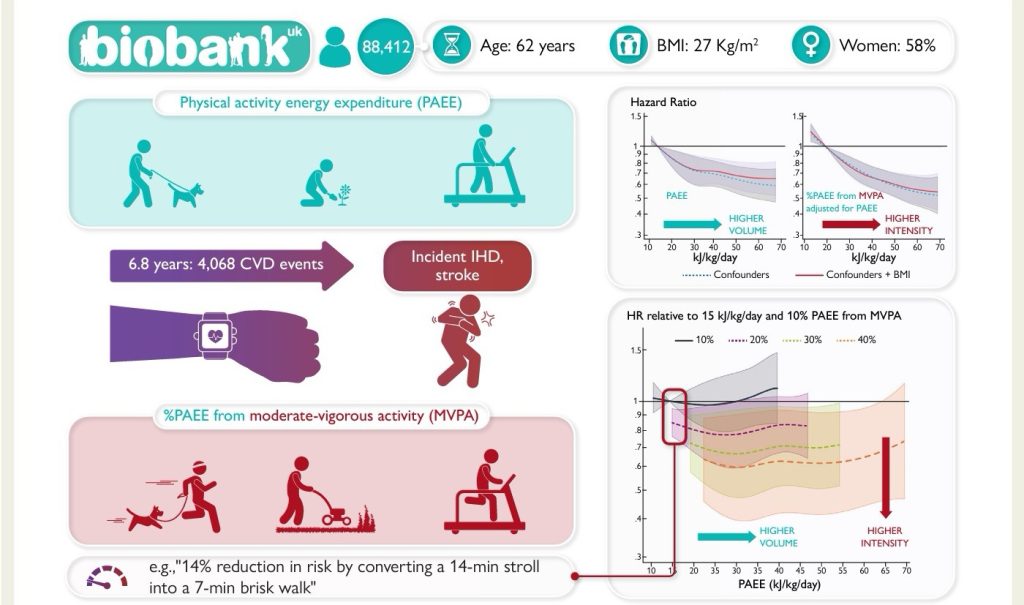Increasing physical activity of any intensity is beneficial for health, but new research published today in the European Heart Journal shows that there is a greater reduction in cardiovascular disease risk when more of that activity is of at least moderate intensity. The study, led by researchers at the University of Cambridge and University of Leicester, analysed wrist-worn accelerometer-measured physical activity data from more than 88,000 UK Biobank participants.
Current physical activity guidelines from the UK Chief Medical Officers recommend that adults should aim to be active every day, and also that adults should undertake 150 minutes of moderate intensity activity (such as a brisk walk) or 75 minutes of vigorous intensity activity (such as running) every week. Physical activity volume is defined as the intensity of the activity multiplied by time, but until recently it has not been clear if overall physical activity volume is what is most important for health, or if more vigorous activity confers additional benefits.
Dr Paddy Dempsey, Research Fellow at the University of Leicester and Medical Research Council (MRC) Epidemiology Unit at the University of Cambridge, and first author on the paper, said:
Most large-scale studies to date have used questionnaires to determine participants’ physical activity levels, but physical activity intensity and duration is hard to recall accurately, especially when it comes to low intensity every day activities like washing the car, or sorting laundry. Without accurate records of physical activity duration and intensity it hasn’t been possible to sort out the contribution of more vigorous physical activity from that of overall physical activity volume.
Wearable devices helped us to accurately detect and record the intensity and duration of movement for 90,000 individual UK Biobank participants, and we recently published an analysis of wearable device data demonstrating that moderate and vigorous intensity activity gives a greater reduction in the overall risk of early death. More vigorous physical activity may also reduce the risk of cardiovascular disease, over and above the benefit seen from the total amount of physical activity, as it stimulates the body to adapt to the higher effort required. This is what we set out to investigate in the research published today.”
The authors investigated the association between physical activity volume and intensity and cardiovascular disease incidence in 88,412 middle-aged adults free from cardiovascular disease in Great Britain. These individuals wore a research-grade activity tracker on their dominant wrist for a week while taking part in the UK Biobank study. The movement data they collected was used to calculate the total volume of activity, and the authors also worked out the percentage of that volume that was achieved through moderate and vigorous intensity activity. The number of cardiovascular events, including ischaemic heart disease or cerebrovascular disease, was then recorded among study participants over an average of follow-up period of 6.8 years.

The authors found that total physical activity volume was strongly associated with a decrease in cardiovascular disease risk, and they also demonstrated that getting more of the total physical activity volume from moderate-to-vigorous physical activity was associated with a further reduction in cardiovascular risk. Cardiovascular disease rates were 14% (95%CI: 5-23%) lower when moderate-to-vigorous physical activity accounted for 20% rather than 10% of overall physical activity energy expenditure, even in those that otherwise had low levels of activity. This is equivalent to converting a daily 14-min stroll into a brisk 7-min walk.
Overall, the lowest cardiovascular disease rates were observed among those UK Biobank participants who undertook higher overall levels of physical activity and a higher proportion of moderate-to-vigorous physical activity. However, interestingly, when overall volume of physical activity increased but the proportion from moderate-to-vigorous activity remained the same, the authors observed little effect on cardiovascular disease rate. For example, when overall physical activity levels were doubled there was no significant effect on cardiovascular disease rates when the proportion from moderate-to-vigorous activity remained at 10%, but the cardiovascular disease rate fell by 23% and 40% when the proportion from moderate-to-vigorous physical activity rose by 20% and 40% respectively.
Professor Tom Yates, professor of physical activity, sedentary behaviour and health at the University of Leicester, and a senior author on the paper, said:
Our analysis of data from UK Biobank confirms that increasing the total amount of physical activity can lower the risk of suffering a heart attack or stroke, but we also found that achieving the same overall amount of physical activity through higher intensity activity has a substantial additional benefit.
Our findings support simple behaviour-change messages that “every move counts” to encourage people to increase their overall physical activity, and if possible to do so by incorporating more moderately intense activities. This could be as simple as converting a leisurely stroll into a brisk walk, but a variety of approaches should encourage and help individuals to find whatever is most practical or enjoyable for them.”
This study was supported by the National Institute for Health and Care Research (NIHR) Leicester Biomedical Research Centre, the MRC Epidemiology Unit, UK Biobank, and NIHR Applied Research Collaborations East Midlands.
Read more
- Dempsey PC, Rowlands AV, Strain T, Zaccardi F, Dawkins N, Razieh C, Davies MJ, Khunti KK, Edwardson CL, Wijndaele K, Brage S, Yates T. Physical Activity Volume, Intensity and Incident Cardiovascular Disease. European Heart Journal: 28 October 2022. DOI:10.1093/eurheartj/ehac613

 MRC Epidemiology Unit
MRC Epidemiology Unit